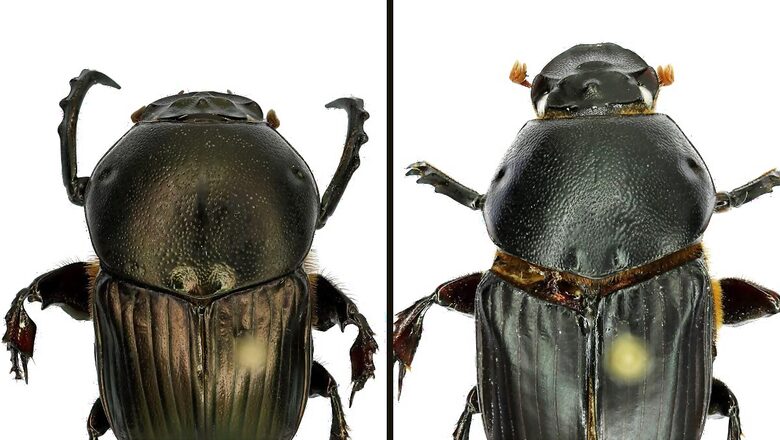
views
Scientists have discovered new species of dung beetle from one of Bengaluru’s last remaining vast grasslands in Hesaraghatta. The latest discovery from India takes the total number of such beetle species reported globally to 179.
The new species discovered by entomologists from the Ashoka Trust for Research in Ecology and the Environment (ATREE), Bengaluru is named – ‘Onitis visthara’ and belongs to a rare family of beetles called Onitis. They are famously referred to as ‘tunnellers’ because they bury large quantities of cattle dung beneath the dung pat to provide food for their offspring. Unlike others, the species is relatively broad, so named ‘visthara’ which means breadth in Kannada.
They also discovered two other species. While one was named ‘Onitis kethai’ after one of the field assistants late Ketha Gouda, the second one was named ‘Onitis bhomorensis’ after the bridge “Kolia Bhomora” across Brahmaputra in the North-east, from where the new species was collected.
These small, but significant insects are often overlooked, but they serve an important ecological function as they can bury and clear away tonnes of cattle dung. This is absolutely critical in a country like India which has one of the largest livestock populations in the world. “Cattle dung is a major source of greenhouse gas emissions which contribute significantly to climate change. But these beetles can bury the dung and help reduce these emissions. While doing this, these beetles also enhance nutrient cycling, improve soil aeration, and help in dispersing seeds and also control parasites” said Dr. Seena Karimbumkara the lead author of the study.
WHY DUNG BEETLES?
An average cow produces approximately 30 kilograms of dung daily, amounting to over 10 tonnes per year. India has one of the world’s largest livestock populations exceeding 535 million, and the copious amount of the dung generated is processed and decomposed by the dung beetles. They feed, breed, and nest in the dung, either burying it or breeding directly within the dung pats.
Entomologists Seena Narayanan Karimbumkara and Priyadarsanan Dharma Rajan from ATREE, Bengaluru have been studying dung beetles for over 20 years especially across the Indian subcontinent. They have conducted in-depth studies, and extensive field collections across India and examined Onitis specimens in all major insect museums worldwide. Recently, two other new species were also discovered from the same family – ‘Onitis kethai’ from Biligiri Rangaswamy Temple Tiger Reserve, Karnataka and ‘Onitis bhomorensis’ from Tezpur, Assam.
SAVE THE ‘DISSAPPEARING’ GRASSLANDS
The latest discovery also throws light on the immense conservation value of the Hesaraghatta grasslands, which are rapidly disappearing due to fast-paced urbanization and other construction projects, despite being home to a diverse array of species. Located in the catchment area of Hesaraghatta Lake in north-west Bengaluru, these grasslands are renowned for their rich biodiversity. Additionally, they serve as an important grazing ground for the livestock of local communities.
Rapid urbanisation, along with growing industrial and commercial activities has placed tremendous pressure on urban green spaces, highlighted the researchers.
“Bangalore’s natural landscape was once dominated by dry deciduous trees, interspersed with wetlands and open grasslands. The Hesaraghatta grasslands and the nearby Avalahalli forests are among the few remaining patches of this original vegetation. Given their rich biodiversity and the valuable ecosystem services they provide, these landscapes should be protected as a biodiversity heritage of Bangalore,” said Dr. Priyadarsanan Dharma Rajan who leads the insect lab at ATREE, Bengaluru.















Comments
0 comment